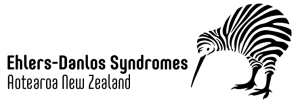What is Classical Ehlers-Danlos Syndrome (cEDS)?
Classical Ehlers-Danlos Syndrome is an inherited connective tissue disorder (Autosomal Dominant – a child of one parent with EDS has a 50% chance of inheriting), that is caused by defects in a protein called collagen. Classical Ehlers-Danlos Syndrome (cEDS) is one of the more common types of EDS, along with Hypermobile Ehlers-Danlos Syndrome (hEDS).
Common symptoms include joint hypermobility, skin hyperextensibility, and skin fragility leading to atrophic scarring and significant bruising. Classical EDS can be diagnosed both clinically and by genetic testing. Classical EDS is usually caused by a change (mutation) in the COL5A1 or COL5A2 gene which involves Type V Collagen, or more rarely a change in the COL1A1 gene, and involves Type 1 Collagen. Treatment and management is focused on relieving the signs and symptoms of cEDS.
Signs & Symptoms
We know that day to day, many people with Classical EDS have no problems and live full and enjoyable lives. However, people with Classical EDS do have fragile connective tissues, as the condition is caused by faulty type V collagen.
What are the main signs and symptoms of Classical EDS?
The signs and symptoms of classical EDS vary but may include:
- Smooth, velvety skin that is highly elastic (stretchy) and bruises easily
- Abnormal wound healing that may result in wide, atrophic scars (flat and/or depressed scars)
- Joint hypermobility that leads to frequent dislocations and subluxations (partial dislocations)
- Molluscoid pseudotumors (calcified hematomas over pressure points such as the elbow)
- Subcutaneous spheroids (fat-containing cysts that are often found on the forearms and/or shins)
- Hypotonia
- Delayed motor development
- Tissue fragility that may lead to hernias, rectal prolapse, and other complications
- Cardiovascular abnormalities such as mitral valve prolapse or aortic root dilatation (enlargement of the blood vessel that distributes blood from the heart to the rest of the body)
- Pregnancy may be complicated by premature rupture of membranes
Occasionally there may be other features present including:
- Chronic constipation
- Fatigue
- Gastroesophageal reflux
- Muscle spasms
- Muscle weakness
- Wounds may take longer to heal.
Skin
Skin involvement is key to establishing the diagnosis of classical EDS. Skin is hyperextensible and soft, often described as velvety, with severe atrophic scarring and haemosiderin deposition over the shins and extensor surfaces. The skin is fragile and tears or bruises very easily.
Musculoskeletal
Joint hypermobility is present. This will be evidenced by the presence of a Beighton score of 5 or greater, either on examination or historically. Joint instability complications may comprise sprains, dislocation/subluxation, temporomandibular joint dysfunction, pain and pes planus, dyspraxia, and early osteoarthritis. Mild muscle hypotonia, and some skeletal morphological alterations (scoliosis, pectus deformities, elbow/genus/hallux valgus) are regularly observed. Pre-menopausal osteopenia or an increased bone fragility in the presence of a bone mineral density within the range may occur
Gastrointestinal
Gastrointestinal complaints are more commonly described in the hypermobile type of EDS, although they can be present in patients with classical EDS and may include:
- Dysphagia
- Dyspepsia
- Reflux disease with or without hiatal hernia
- Irritable-bowel disease-like symptoms
- Unspecified abdominal pain
- Defecatory dysfunctions (constipation, diarrhea), and rectocele
Classical EDS Diagnosis
To meet the diagnostic criteria for cEDS, a person must meet:
- Major criterion 1 AND Major criterion 2
OR
- Major criterion 1 AND three or more minor criteria
Major Criteria Include
- Skin hyperextensibility and atrophic scarring
- Generalized joint hypermobility
Minor Criteria Include
- Easy bruising
- Soft, doughy skin
- Skin fragility (or traumatic splitting)
- Molluscoid pseudotumors
- Subcutaneous spheroids
- Hernia (or history thereof)
- Epicanthal folds
- Complications of joint hypermobility (e.g., sprains, dislocations/subluxations, pain, flexible flatfoot)
- Family history of a first-degree relative who meets clinical criteria
Sources: Source: [1 Classical Ehlers-Danlos syndrome | Genetic and Rare Diseases Information Center (GARD) – an NCATS Program (nih.gov)] [2 About EDS | Ehlers Danlos Syndromes New Zealand (ehlers-danlos.org.nz)] [3 Ehlers-Danlos Society] [4 2017 International Classification of the Ehlers-Danlos Syndromes] [5 Hypermobility and Ehlers-Danlos Syndromes (EDS) – New Zealand Guideline 2019]
Support for Classical Ehlers-Danlos Syndrome
Please feel free to join our Nationwide Support Group “Loosely Speaking” on Facebook, or check out our more localised support groups to see if there is one within your area.
EDSNZ are working at compiling a list of resources of services and support you may be interested in. Among these are:

